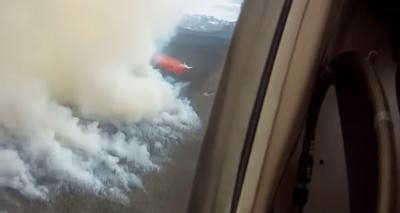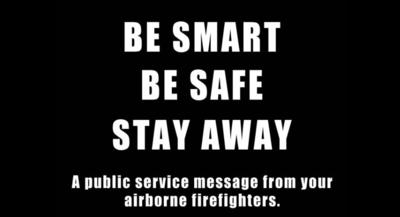Thu, Jul 30, 2015
Several Recent Incidents Reported In Which UAVs Interfered With Firefighting Aircraft
Responding to recent incidents in which unmanned aircraft systems (UAS), also known as “drones,” interfered with manned aircraft involved in wildland firefighting operations, the FAA is supporting the U.S. Department of the Interior and U.S. Forest Service in their simple message to drone operators: If you fly; we can’t.

“Flying a drone near aerial firefighting aircraft doesn’t just pose a hazard to the pilots,” said U.S. Transportation Secretary Anthony Foxx. “When aircraft are grounded because an unmanned aircraft is in the vicinity, lives are put at greater risk.”
Often a temporary flight restriction (TFR) is put in place around wildfires to protect firefighting aircraft. No one other than the agencies involved in the firefighting effort can fly any manned or unmanned aircraft in such a TFR. Anyone who violates a TFR and endangers the safety of manned aircraft could be subject to civil and/or criminal penalties. Even if there is no TFR, operating a UAS could still pose a hazard to firefighting aircraft and would violate Federal Aviation Regulations.
“The FAA’s top priority is safety. If you endanger manned aircraft or people on the ground with an unmanned aircraft, you could be liable for a fine ranging from $1,000 to a maximum of $25,000,” said FAA Administrator Michael Huerta. “Know the rules before you fly. If you don’t, serious penalties could be coming your way for jeopardizing these important missions.”
Since so many people operate unmanned aircraft with little or no aviation experience, the FAA is promoting voluntary compliance and working to educate UAS operators about how they can operate safely under current regulations and laws. The agency has partnered with industry and the modeling community in a public outreach campaign called “Know Before You Fly.”

The campaign recently reminded UAS users to respect wildfire operations. The National Interagency Fire Center also posted a video warning for users to, “Be Smart. Be Safe. Stay Away.”
Additionally, the FAA provided guidance to law enforcement agencies because they are often in the best position to deter, detect, immediately investigate, and, as appropriate, pursue enforcement actions to stop unauthorized or unsafe unmanned aircraft operations.
So remember this simple message around wildfires: If you fly, they can’t. Keep your drone on the ground and let firefighters and aircraft do their jobs. And, if you see someone flying a drone near a wildfire, report it immediately to local law enforcement and the nearest FAA Flight Standards District Office with as much information as possible.
(Images from YouTube video)
More News
From 2021: The Inside Skinny On What Being An ANN Oshkosh Stringer Is All About By ANN Senior Stringer Extraordinare, Gene Yarbrough The annual gathering at Oshkosh is a right of p>[...]
Video Showed That During The Takeoff, The Nose Baggage Door Was Open On May 10, 2025, about 0935 eastern daylight time, a Piper PA-32RT-300, N30689, was destroyed when it was invol>[...]
Get The Latest in Aviation News NOW on Instagram Are you on Instagram yet? It's been around for a few years, quietly picking up traction mostly thanks to everybody's new obsession >[...]
"I think what is key, we have offered a bonus to air traffic controllers who are eligible to retire. We are going to pay them a 20% bonus on their salary to stay longer. Don't reti>[...]
Aero Linx: Pilot Briefing The gathering, translation, interpretation, and summarization of weather and aeronautical information into a form usable by the pilot or flight supervisor>[...]
 Oshkosh Memories: An Aero-News Stringer Perspective
Oshkosh Memories: An Aero-News Stringer Perspective NTSB Prelim: Piper PA32RT
NTSB Prelim: Piper PA32RT ANN FAQ: Follow Us On Instagram!
ANN FAQ: Follow Us On Instagram! Aero-News: Quote of the Day (05.28.25)
Aero-News: Quote of the Day (05.28.25) ANN's Daily Aero-Term (05.28.25): Pilot Briefing
ANN's Daily Aero-Term (05.28.25): Pilot Briefing




